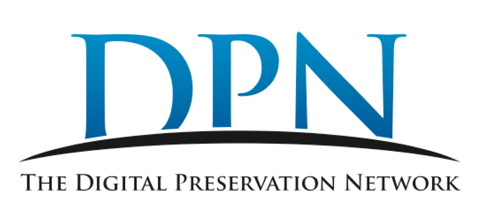The long term stewardship of digital objects and collections through digital preservation is an essential imperative for scholarship and society. Yet its value is intangible and its rewards are deferred. It falls on organizations to invest in preservation, often less out of a sense of anticipated exclusive returns and more out of a sense of contributing to a community mission. It is against this backdrop that today I examine the announced closure of the Digital Preservation Network.
The vision for the Digital Preservation Network (DPN) was outlined in an early overview that illustrates much of the founders’ thinking. It was established to solve two problems at once. First, its founders observed that not all preservation services at the time were as resilient as one might hope, and so, “the heart of DPN is a commitment to replicate the data and metadata of research and scholarship across diverse software architectures, organizational structures, geographic regions, and political environments.” Second, as far too little scholarly content was being preserved, DPN would also enable existing preservation capacity to be utilized for a wider array of purposes, recognizing that, “once that infrastructure is in place, it can be extended at much lower marginal costs.” In one sense, DPN thereby offered an elegant technical solution. But as elegant as it may have been technically, its product offering was never as clear as it could have been. And as much as it accomplished, it ultimately could not be sustained.
I have long been interested in organizational development, strategy, and demise in the scholarly communications sector. I recently analyzed DPLA’s “pivot” and associated layoffs. In preparing to write about DPN over the past week, I have been impressed with the efforts its staff and leadership have made towards transparency and learning lessons in this difficult period. DPN has released information about some of the lessons it believes can be learned from its experience. I was able to speak with DPN executive director Mary Molinaro and board member James Hilton, university librarian at Michigan, as well as gather perspectives from a number of member and former member libraries. As I said in writing about DPLA, it is essential that we engage in open discussion of lessons we can learn from organizational challenges, and I am grateful for DPN leaders for their willingness to speak with me directly.
Business Models for Preservation
In recent years, tremendous progress has been made by preservationists, both at technical and organizational levels. As Kate Wittenberg and Sheila Morrissey wrote this fall, Portico has reinvested to build an entirely new platform. (Like Ithaka S+R, where I work, Portico is also a service of the same parent organization, ITHAKA.) And as Craig Van Dyck shared with me in a recent interview, CLOCKSS has developed a succession plan. But while the preservation of scholarly publications may be in relatively good hands, there are also important gaps. My colleague Oya Rieger recently wrote an important summative overview of the state of digital preservation, finding some key gaps in organizations and leadership, preservation services and program areas, and assessment, evaluation, and risk management. The Digital Preservation Network’s disbandment makes clear some real challenges.
DPN’s membership at one point reached a high of 62, from which it had declined gradually and then substantially this past summer, reaching a low of 31 members. At this level of membership, it became clear to the staff and the board that DPN could no longer be sustained. At the highest level, the membership decline can be attributed to a single factor: only 27 members ever deposited content into DPN. But this serves only to raise the related questions, why did more members not use the preservation services of DPN and why did membership decline? While I cannot characterize the motivations of every single member, some patterns appear to have emerged.
- Not every storage need requires a preservation solution. Many university members had made substantial investments to move the university’s enterprise storage to cloud providers and could not understand why the library was proposing a separate solution. CIOs and others were comfortable that cloud solutions were secure enough for almost all purposes. At the same time, many members were actually uncomfortable with the long-term preservation commitments they did not directly manage, including explicit succession planning; in some cases, they were looking for a solution that retained more institutional control. DPN and its members were, in some cases, unsuccessful in distinguishing the added value of a preservation solution from cloud storage.
- Many library systems were not originally prepared to support DPN’s ingest workflow. In a number of member libraries, the content that was to be preserved with DPN was housed on an array of servers and systems, often with limited curatorial control. It took some time before these libraries were able to flow content to DPN.
- A rigorous product definition took too long to emerge. DPN originally approached the library community as something of a digital preservation movement. It had a strong technical vision, but a clear product offering took time to emerge and the value proposition was not uniformly understood. This made it more difficult to generate library and partner engagement after the period of initial enthusiasm.
- DPN’s pricing model imposed obstacles on growth. A fixed annual deposit allocation was included in membership and additional storage could be obtained for an additional fee. Some members would consequently cap their deposit activity when they reached the membership ceiling, in the hopes of flowing further content to DPN during the next membership year. This had the effect of limiting the value of membership and eliminating the extra fees that DPN had anticipated generating as revenue. Even during DPN’s early years, when the membership was higher, existing members did not generate the revenue that DPN’s model anticipated.
- Some libraries were never invested in their membership. It was comparatively easy to get several dozen libraries to sign up to pay a $20,000 annual membership fee, especially after Hilton met with AAU presidents and pitched an early vision of DPN to them. One reader suggested to me that initial sign-ups may have been more out of courtesy or community citizenship than commitment.
- Membership models are ill-suited to product organizations and marketplace competition. Academic libraries, at least, face too many possible organizational memberships today, and many of them are being scrutinized for their actual value. While memberships have proved to be a durable way to fund certain kinds of “clubs” such as professional organizations, they seem to be misaligned when there is a need to match value with actual products or services. Membership organizations necessarily seek a degree of consensus in their governing and cross-subsidization in their fee structures, while product organizations need to be able to deliver a clear solution to a well-defined problem for a reasonable price and to adapt their approach aggressively as marketplace conditions dictate.
As the academic community, and its libraries in particular, have moved into a period of more rigorous value assessment and more strategic resource allocation, the cumulative effect of these issues became more acute. While there may have been other factors as well, fundamentally DPN’s limitations appear to have been about its product, value proposition, and business model. An initial burst of membership masked some fundamental, perhaps inevitable, challenges.
Communications and Sunset
The membership decline accelerated at the beginning of this fiscal year. At that point, the staff and board began to consider a variety of alternative options, including tiered memberships and other ways to rethink the membership model. In the end, I am told, they concluded that there was no feasible option to continue operations, and they (through a governance arrangement that has had DPN connected to Internet2) elected to disband DPN.
There was a period of months when DPN ceased accepting new deposits, because its leaders knew that a wind-down was under way, but during which it was advised by counsel that it could not explain the reason to its partners. When the announcement was finally made, earlier in December, the communications were clear and unequivocal. An initial announcement said directly that “After careful analysis of the Digital Preservation Network’s membership, operating model, and finances, the Board of Trustees of DPN passed a resolution to affect an orderly wind-down of DPN,” including committing to consultations with each member to ensure that content would not be lost in the wind-down. Shortly thereafter, messages came out from DPN’s hubs, both individually including HathiTrust, and collectively, characterizing their operating and financial strength and ability to provide for an orderly transition. Because DPN was not itself directly preserving anything but rather a broker for preservation services by underlying repositories, it does not appear that any content will be put at risk. Communications associated with a major disruptive organizational change are always tricky, but this messaging has been direct and well handled.
DPN never had a large staff, but its three employees will each lose their jobs. Because the wind-down has been clear to the staff for many months, Molinaro says there has been enough advance notice and support that each has been able to find their future directions.
Stability and Consolidation
There are broader implications in the disbandment of DPN. Earlier this year, the California Digital Library announced a pivot and partnership with Dryad, determined through a period of self reflection. Last month, we learned about the pivot and job losses at the Digital Public Library of America. Earlier this week, Jisc and Eduserve (provider of authentication service OpenAthens) announced a merger. DPN will not be the last closure, merger, or other notable reorganization we will see. It seems clear that we are in a period of instability for collaborative library community efforts and more major changes are surely on the horizon.
Any reorganization is difficult for those involved. At the same time, the library and scholarly communications communities have created more small independent collaborative organizations than we can possibly sustain. We need, and are experiencing, consolidation.
Consolidation in this sector can arise in one of two ways — through pivots and shut-downs as services decline and organizations fail, or through value-creating reorganizations and mergers among organizations that are doing fine but should be able to deliver more.
In either case, the solution is not, in my view, a major turn towards central planning to create a planned economy or single “ideal” platform or organization. For scientific workflow tools and research management infrastructure, we are seeing major consolidation spearheaded by the acquisition of startups and privately owned companies by several major players. This consolidation is not without flaw, and I have urged universities to be cautious about outsourcing core research infrastructure, but so far despite that consolidation there remains meaningful marketplace competition. Central planning would have the opposite effect.
By contrast, there is a far more difficult and politically sensitive path ahead to drive consolidation in a community over-supplied with not-for-profit organizations, including many membership organizations. Are leaders, including board members, prepared to consolidate in order to create value, not only because organizations are at the point of failure? If other mergers and wind-downs can happen with the level of care and responsibility that DPN and its leaders appear to have pursued, this will be in the best interests of the community and the long-term stability of our most important collaborations.
My thanks to colleagues who reviewed a draft of this piece: Dennis Clark, Kevin Guthrie, Lisa Janicke Hinchliffe, Kimberly Lutz, Deanna Marcum, Tim McGeary, Susan Parker, and Oya Rieger.
Discussion
6 Thoughts on "Why Is the Digital Preservation Network Disbanding?"
Here in Scotland we are big fans of https://www.dpconline.org/
Very nice, Roger. Cogent, concise, on point. As you do so well. With thanks, Brian S.
Roger, thanks for this instructive analysis. I was an early participant on the DPN Board and saw the possibilities of success with the the engagement of senior university administrators and with the technical strategy DPN was implementing. I am deeply concerned about our collective ability to capture and preserve the digital scholarly record as well as the vast array of dynamic and multimedia born digital content which supports scholarship. Especially if we are having difficulty sustaining such collaborative organizations in the library and university communities.
Roger, a cogent analysis on all points, not just about the reasons for the closure of DPN, but for the general lessons that many non-profits (in libraries and outside of the profession) began to experience during the 2009 recession. In many respects, what we are seeing is a continuation of a pattern that started then, and these latest closures or pivots are symptomatic of the underlying problems you identify. One other point I would raise, to which you make some allusion, is that perhaps the answer is not so much mergers and consolidations, but that issues such as digital preservation can and should find a home in existing organizations when it is consistent with their mission. For digital preservation, where in their vision are, for example, library collaborative organizations such as OCLC, HathiTrust, Portico, or the Center for Research Libraries? I am not advocating mission creep, but rather issues such as digital preservation could be an reasonable expansion not only of their existing mission, but a leveraging of substantial existing infrastructures.
Arnold makes a good point — do we need a new organization for every new mandate or opportunity? Could we not proactively shape future directions with our current arrangements and collaborations that would have more stability and be buffeted less by short-term influences?
A successful product fulfills a want, need or desire. It seems that one of all were missing in this case.
The basic difference between wants and demands is desire. A customer may desire something but he may not be able to fulfill his desire. … The needs wants and demands are a very important component of marketing because they help the marketer decide the products which he needs to offer in the market.Dec 15, 2017
Needs wants and demands – Understanding the difference between all 3
https://www.marketing91.com/needs-wants-and-demands/




